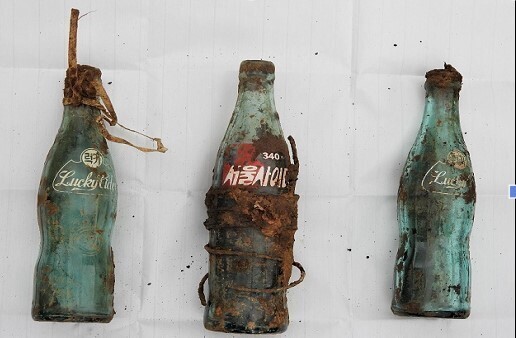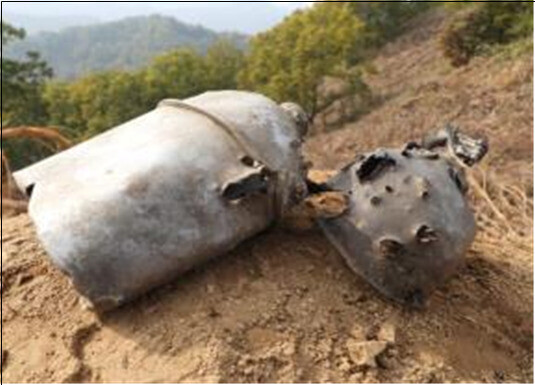hankyoreh
Links to other country sites 다른 나라 사이트 링크
Korean War soldier remains, soda bottle Molotov cocktails excavated along DMZ

The Ministry of National Defense on Thursday said it has excavated the remains of 26 soldiers and 5,132 personal effects from the area around White Horse Ridge in Cheorwon County, Gangwon Province. Excavation efforts began last month at the Korean War battlefield located within the Demilitarized Zone.
The ministry’s Agency for Killed in Action Recovery and Identification will seek to confirm the identities of the deceased through precision identification and DNA analysis. The remains and personal effects found are a testament to how fierce the battle was at the time, the ministry said.
In October 1952, the 9th Infantry Division of the Republic of Korea (ROK) Army engaged in a fierce firefight against Chinese forces three times greater in number at the ridge. During the 10-day battle, Korean forces engaged in 12 attack and defensive battles as the ridge repeatedly changed hands. ROK forces defeated 13,000 Chinese soldiers in a regional battle, a feat considered to be without precedent in world history. Following their victory, the division received the title of "Rising White Horse" and the moniker of “White Horse Division.”
The ministry said it confirmed that the positions of the private and transportation vessels in the area around White Horse Ridge — also known as Baengmagoji — were more than twice as deep as those in neighboring Arrowhead Ridge (Hwasalmeori). Human remains and relics at White Horse were excavated at a depth of 1.5 meters (roughly 5 feet), far deeper than at Arrowhead (60 centimeters, or 2 feet).

The fierce battle there saw the area change hands seven times over the course of 10 days, and both South and North Korean soldiers dug deeper positions to survive the artillery onslaught. The 26 remains were found partially intact, and the ministry said their state could shed light on the extent of damage from shelling during the Battle of White Horse.
Molotov cocktails made from soda bottles were additionally discovered. The ministry said that in the process of taking the hill, ROK forces used such cocktails at a critical juncture when their ammunition was exhausted. A canteen riddled with bullet holes also discovered illustrates just how brutal the battle was.
In October 1952, White Horse Ridge was a major battle front line along the central front of the Korean War. As both Koreas fought a war that traversed the entirety of the Korean Peninsula, the front line came to a stalemate in the vicinity of today’s Military Demarcation Line during two years of truce talks from July 10, 1951, to July 27, 1953. During this period, capturing just an inch of land required fierce battles fought on the central and eastern fronts. Most of the war’s casualties occurred on the front lines.
The ministry continues to excavate the White Horse Ridge area of the Demilitarized Zone for remains following the findings of the excavation of Arrowhead Ridge, which began as part of the 2018 inter-Korean military agreement. Excavation work will include studying the records of battles in the war, testimonies of veterans who fought at White Horse Ridge and the topography of the ridge’s site.
By Kwon Hyuk-chul, staff reporter
Please direct questions or comments to [english@hani.co.kr]

Editorial・opinion
![[Column] Season 2 of special prosecutor probe may be coming to Korea soon [Column] Season 2 of special prosecutor probe may be coming to Korea soon](https://flexible.img.hani.co.kr/flexible/normal/500/300/imgdb/original/2024/0426/3317141030699447.jpg) [Column] Season 2 of special prosecutor probe may be coming to Korea soon
[Column] Season 2 of special prosecutor probe may be coming to Korea soon![[Column] Park Geun-hye déjà vu in Yoon Suk-yeol [Column] Park Geun-hye déjà vu in Yoon Suk-yeol](https://flexible.img.hani.co.kr/flexible/normal/500/300/imgdb/original/2024/0424/651713945113788.jpg) [Column] Park Geun-hye déjà vu in Yoon Suk-yeol
[Column] Park Geun-hye déjà vu in Yoon Suk-yeol- [Editorial] New weight of N. Korea’s nuclear threats makes dialogue all the more urgent
- [Guest essay] The real reason Korea’s new right wants to dub Rhee a founding father
- [Column] ‘Choson’: Is it time we start referring to N. Korea in its own terms?
- [Editorial] Japan’s rewriting of history with Korea has gone too far
- [Column] The president’s questionable capacity for dialogue
- [Column] Are chaebol firms just pizza pies for families to divvy up as they please?
- [Column] Has Korea, too, crossed the Rubicon on China?
- [Correspondent’s column] In Japan’s alliance with US, echoes of its past alliances with UK
Most viewed articles
- 1Samsung subcontractor worker commits suicide from work stress
- 2‘We must say no’: Seoul defense chief on Korean, USFK involvement in hypothetical Taiwan crisis
- 3Is Japan about to snatch control of Line messenger from Korea’s Naver?
- 4Division commander ordered troops to enter raging flood waters before Marine died, survivor says
- 5[Editorial] Korea’s surprise Q1 growth requires objective assessment, not blind fanfare
- 6No good, very bad game for Korea puts it out of Olympics for first time since 1988
- 7US overtakes China as Korea’s top export market, prompting trade sanction jitters
- 8Korea’s 1.3% growth in Q1 signals ‘textbook’ return to growth, says government
- 9N. Korean delegation’s trip to Iran shows how Pyongyang is leveraging ties with Moscow
- 10[Column] Season 2 of special prosecutor probe may be coming to Korea soon